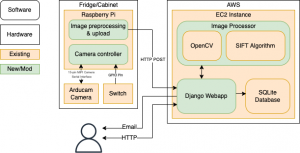Feb 19
This week has mostly been finalizing the details of our project in preparation for the design presentation/documentation. At this point, we feel fairly confident in the status of our project, and our ability to execute it.
Major design decisions:
- Cut back on the scope of the project/increased the burden placed on the user.
- Scale back scope of website
- Commit to SQLite
- Reorganized Gantt chart
- Finalized overall design
1) On the advice of Prof. Savvides and Funmbi, we decided to decrease the scope of this project by imposing the following requirements on the user:
- The objects must be stored such that the label is visible to the camera
Originally, it was near impossible to identify an item using ORB/SIFT/BRIEF unless the label was facing the camera. We initially tried to resolve this by resorting to using some sort of R-CNN/YOLO with a dataset which we would manually annotate. However, the process of generating enough data to make it viable was too much work, and it didn’t guarantee our ability to resolve the issues. As such, we are adding this requirement to the project, to make it viable in the given time frame.
- The user can only remove/add one item at a time
This is a requirement which we impose in order to handle unsupported items/allow registration of new items. When the user adds a new item which we do not support, we can perform a pixel diff between the new image of the cabinet and the previous image before the user added the unknown item. We are not currently working on this, but it will become important in the future.
- Finalized the algorithm (SIFT) and finalized supported grocery list
Baseline SIFT performed the best in our previous experiments, and continued to perform better this week when we were adjusting the grocery list. We may experiment with manually changing some of the default parameters while optimizing, but we expect to use SIFT moving forward. When basic eye tests with various common items, we found these items to perform well with the label visibility restriction: Milk, Eggs, Yogurt, Cheese, Cereal, Canned Beans, Pasta, and Ritz crackers.
2) Additionally, with input from both Prof. Savvides and Funmbi, we’ve majorly cut back on the stretch goals we had for the website. Given that this project is meant more as a proof of concept of the computer vision component rather than an attempt to showcase a final product, we’ve used that guideline to scale back the recipe suggestions and modal views of pantry lists. The wireframing for the website isn’t as rigorous anymore, though I (Jay) still want to explore using Figma (more in my personal blog post).
Account details won’t be as rigorous of a component as we had initially envisioned, and, given that performance isn’t as much of a concern for a few dozen entries per list, we’ve decided to stick with SQLite for the database.
3) Minor housekeeping: after seeing what other groups did for their Gantt charts, we decided that converting our existing Gantt chart into a format requiring less proprietary software would be beneficial for everyone and make updating it less time consuming. Updates to the categories (for legibility) and dates (for feasibility) have been made. New Gantt chart can be found here.
We also moved to a shared github group, code can be found at: https://github.com/18500-s22-b6.
4) Finalized overall design. After some discussions, we finalized the design of the different components of our project. For the physical front end, we found appropriate hardware and placed the order. For the backend, we decided to use a single EC2 instance to run the webapp and the CV component. Although scalability is important for smart appliances, it is not the priority for this project. Instead, we will put our focus on the CV component and make sure it works properly. We do have a plan to scale up our project, but we will set that as a stretch goal.

